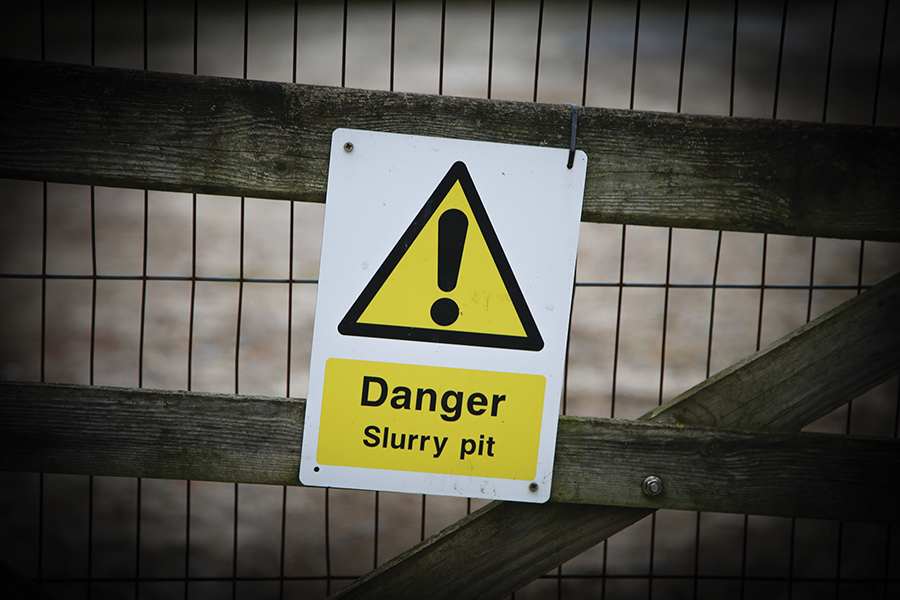The health and safety considerations when managing slurry
24th November 2023
Gavin Scarr-Hall, director of health & safety at Peninsula, offers some advice on best practice for slurry management.

Within the health and safety team, we talk a lot about proportionate measures. This means that nobody should have to invest in control measures that are unnecessary compared to the level of risk faced. But there is no avoiding it; agricultural work has one of the highest levels of risk of death or serious injury of any industry in the UK. There were 21 fatal injuries last year alone.
This is why the Health and Safety Executive (HSE) expects a much higher standard of safety management for farming than in most other sectors, and slurry management carries one of the highest risks.
Toxic gas
Slurry gas is incredibly toxic, and fatal exposures can happen rapidly and without warning if the correct safety measures are not in place.
Slurry is essentially manure and water. When these two elements combine, a chemical reaction takes place, producing gases such as hydrogen sulphide, ammonia, methane, and carbon dioxide. The odourless nature of these gases makes them hard to detect, which poses a huge risk. When inhaled these gases lead to discomfort, disorientation, and loss of consciousness – in extreme circumstances, this can be fatal.
Many underestimate the dangers of managing slurry, as it cannot be smelt in high concentrations.
Due to the high toxicity levels, it can be very easy for workers to become overwhelmed and lose the ability to save themselves if they fall in. Livestock or children may also be in the area, sometimes unsupervised, so it’s vital to have proper fencing and adequate safety precautions to prevent animals or people who are not properly trained in slurry handling from getting in danger.

Regular checks and training
It’s also important to have regular checks and balances to ensure that all the safety measures you put in place are properly maintained and working. It is management’s responsibility to make sure that all members of staff undergo the correct health and safety training to make them aware of all the dangers they will face on the farm.
Reinforce risk awareness training by installing secure fencing, exclusion zones, and a clear warning to show when the slurry is being mixed.
Toxic gases are released when slurry is disturbed, so everyone on the farm should know to stay away when mixing or pumping and the risk prevalent during this period. Ventilation and high levels of awareness from staff need to be considered – lone workers pose a significant risk therefore it is key to staff activities appropriately.
Workers should leave the store following any pumping or mixing to let the fumes disperse. Buildings must be ventilated for at least 30 minutes before anyone re-enters after the slurry is disturbed.
Even outdoors, the gases are not sufficiently ventilated to reduce the risk of inhalation due to the sheer toxicity of the slurry, so don’t just assume that you are safe because you’re working outdoors.
Never stand over mixing pots, reception pits, or slats as the risk of drowning in slurry poses a huge risk. If there’s no alternative to working inside a slurry storage system, then specialist confined space contractors should be used to do the work.
All staff who are working on slurry should be wearing a harness and lifeline system. This will make it quicker and easier to rescue anyone who becomes overcome by fumes without anyone else needing to put themselves in danger by entering the system.
Suitable materials such as small-mesh wire should be used to prevent handholds, as well as barbed wire at the top and bottom to ensure that livestock cannot push through the fence.
Stores with a scraping ramp need to consider the risks involved for tractor drivers. As a precautionary measure you should install extensions at the top and bottom of the fence, or swinging flaps attached to the tractor stop rail.
Although this may seem like a list of control and precautionary measures, they are all proportional to the risks involved with slurry handling, although these risks will vary from farm to farm.
However, while the risks may vary, the level of training, supervision, and contingency plans that should be in place do not. Therefore, it’s important to ensure that if you are unable to eliminate the risk to your workers with relevant control measures, this dangerous work should only be carried out by specially trained experts who can meet the standards required.
Read more slurry articles here


